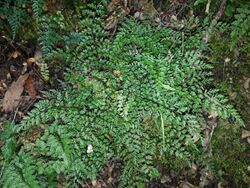Biology:Asplenium hookerianum
| Asplenium hookerianum | |
|---|---|

| |
| Scientific classification | |
| Kingdom: | Plantae |
| Clade: | Tracheophytes |
| Division: | Polypodiophyta |
| Class: | Polypodiopsida |
| Order: | Polypodiales |
| Suborder: | Aspleniineae |
| Family: | Aspleniaceae |
| Genus: | Asplenium |
| Species: | A. hookerianum
|
| Binomial name | |
| Asplenium hookerianum | |
Asplenium hookerianum, commonly known as Hooker's spleenwort, rocklax and maidenhair fern, is a small fern native to New Zealand and Australia .[3][4][5]
Description
This small fern may be found two forms. The broad-pinnuled version's fronds have rounded ultimate segments while the narrow-pinnuled version has very fine and narrow ultimate segments.[4]
Distribution
Asplenium hookerianum is found in New Zealand (including the Chatham Islands) and Australia.
New Zealand
Found throughout the North and South Islands of New Zealand. Less common in Northland, inland Taranaki, western Waikato, King Country and the West Coast.[3][4][6]
Its range extends to Stewart Island and the Chatham Islands although it is uncommon.[3]
Occurs in lowland and montane forests, on shaded clay banks and rocky outcrops, in shrubland and open forest. May also be found among grass and in open pasture, under pine and macrocarpa trees, and in disturbed forest remnants.[3][4][6]
In the South Island, it is mostly confined to lowland areas. In the North Island, it can reach altitudes of up to 1375 metres but is less common above 1000 metres on both islands.[6]
Australia
Found in Tasmania and Victoria where an estimated 700 plants live in four wild populations. Little is known about the previous distribution of this species.[3][7]
In Tasmania, it occurs in rainforest, usually on the heavily shaded margins of waterways and vertical banks. It may also be found in sheltered gullies within drier forests. Can also be found growing on the lower trunks of soft tree-ferns. They may reach altitudes of up to 500 metres.[7]
In Victoria, it occurs on sheltered rock faces in cracks and crevices under overhangs. They may reach altitudes of up to 1,200 metres. Because of its preference for cold and wet environments, it may be impacted by climate change in the future.[7]
Taxonomy
First described by Raoul in 1844 as Asplenium adiantoides. This name was disregarded due to conflicting earlier homonyms. It was later described by Colenso in 1845.[6]
It was named after British botanist Sir Joseph Dalton Hooker.[3]
A global phylogeny of Asplenium published in 2020 divided the genus into eleven clades,[8] which were given informal names pending further taxonomic study. A. hookerianum belongs to the "Neottopteris clade", members of which generally have somewhat leathery leaf tissue. It formed a clade with A. bulbiferum, A. cimmeriorum, and A. richardii.[9]
Lifecycle
Asplenium hookerianum produces spores that are dispersed by wind.[10]
Conservation
In New Zealand, A. hookerianum is listed as Not Threatened.[11]
In Tasmania, it is listed as Endangered. In Victoria, it is listed as Vulnerable. Not much is known about the threats to A. hookerianum. Intensive farming, forestry, and cliff-based recreational activities such as abseiling and rock climbing may have some impact.[5]
Cultivation
Asplenium hookerianum is easily grown and makes a good pot plant, though it is slow growing. It is prone to scale and mealy bug infestations. It is not commercially available.[3]
References
- ↑ "Asplenium hookerianum". Australian Plant Name Index (APNI), IBIS database. Centre for Plant Biodiversity Research, Australian Government. https://biodiversity.org.au/nsl/services/rest/name/apni/105521.
- ↑ Colenso, W. (1845) A Classification and description of some newly discovered ferns, collected in the northern island of New Zealand, in the summer of 1841-42. Tasmanian Journal of Natural Science, Agriculture, Statistics, etc 2(8): 169
- ↑ 3.0 3.1 3.2 3.3 3.4 3.5 3.6 "Asplenium hookerianum var. hookerianum | New Zealand Plant Conservation Network". http://www.nzpcn.org.nz/flora_details.aspx?ID=2056.
- ↑ 4.0 4.1 4.2 4.3 Metcalf, L. J. (Lawrence James) (2003). A photographic guide to ferns of New Zealand. Auckland, N.Z.: New Holland. ISBN 1877246948. OCLC 53001284.
- ↑ 5.0 5.1 Environment, jurisdiction=Commonwealth of Australia; corporateName=Department of the. "Asplenium hookerianum — Maidenhair Spleenwort" (in en). https://www.environment.gov.au/cgi-bin/sprat/public/publicspecies.pl?taxon_id=3909.
- ↑ 6.0 6.1 6.2 6.3 "Flora of New Zealand | Taxon Profile | Asplenium hookerianum". http://www.nzflora.info/factsheet/taxon/Asplenium-hookerianum.html.
- ↑ 7.0 7.1 7.2 Sutter, Geoff. (2010). National recovery plan for the maidenhair spleenwort, Asplenium hookerianum. Victoria. Department of Sustainability and Environment., Australia. Department of the Environment, Water, Heritage, and the Arts., Tasmania. Department of Primary Industries, Water, and Environment.. Melbourne: Dept of Sustainability and Environment. ISBN 9781742420646. OCLC 696067764.
- ↑ Xu et al. 2020, p. 27.
- ↑ Xu et al. 2020, p. 31.
- ↑ Thorsen, Michael J.; Dickinson, Katharine J.M.; Seddon, Philip J. (2009-11-20). "Seed dispersal systems in the New Zealand flora" (in en). Perspectives in Plant Ecology, Evolution and Systematics 11 (4): 285–309. doi:10.1016/j.ppees.2009.06.001.
- ↑ de Lange, Peter J.; Rolfe, Jeremy R.; Barkla, John W.; Courtney, Shannel P.; Champion, Paul D.; Perrie, Leon R.; Beadel, Sarah M.; Ford, Kerry A. et al. (2013-08-01). "Conservation status of New Zealand indigenous vascular plants, 2012". New Zealand Threat Classification Series 3: 1–70. https://www.wikidata.org/wiki/Q57707262.
- Xu, Ke-Wang; Zhang, Liang; Rothfels, Carl J.; Smith, Alan R.; Viane, Ronald; Lorence, David; Wood, Kenneth R.; Cheng, Cheng-Wei et al. (2020). "A global plastid phylogeny of the fern genus Asplenium (Aspleniaceae)". Cladistics 36 (1): 22–71. doi:10.1111/cla.12384. PMID 34618950. https://onlinelibrary.wiley.com/doi/abs/10.1111/cla.12384.
Wikidata ☰ Q17170231 entry
 |

